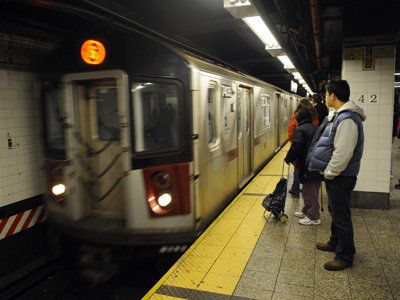
MTA Chief Likes Congestion Pricing
There's a state budget crisis that could bring big service cuts or more fare hikes, but Jay Walder has bigger concerns on his mind. The new chairman of New York City's MTA, formerly of the London Underground, wants to introduce smart cards, arrival-time clocks at subway stations and GPS devices that would allow passengers to keep track of buses. But his big breakthrough could be a lower off-peak fare that could nudge more New Yorkers onto the subway on nights and weekends, and lessen the crush at rush hour.
"We have an infrastructure that is set for the capacity of the peak," Walder told the Times. "What we really want to do is use that infrastructure all the time."
And now -- amidst a budget crisis and a downturn -- could be just the time to do it.
You Already Built It; Will They Come?
Walder's point about infrastructure is precisely why off peak fares are a good idea. The costs of running a built-out, 24-hour subway system like New York's are largely based on peak usage: as long as the subway has to be prepared to handle a million people during the day, the costs of operating the system at night are roughly the same, no matter how many people are riding. Even there's one lonesome straphanger or passed-out reveler riding home at 3 in the morning, the subway's capacity expenses are basically unchanged; a discounted off-peak fare only makes the subway more competitive with taxis and cars.
Consider cell phones. Cell phone users (who may someday soon be able to make calls in New York's subway stations) know that calling is cheaper on nights and weekends. AT&T isn't being nice -- it's simply making use of a system it's already paying for and attracting more customers to sign contracts in the process.
This isn't the first time the idea has been proposed. William Vickrey, a Columbia University economist and 1996 Nobel laureate, suggested it back in 1952. It's come up again a number of times, most recently in 2007. But the technology to do it -- namely, a computerized fare card system -- hasn't really been ready until now.
Walder says he's focused on timing, and isn't thinking of a distance-based fare like the kind used on the London and Washington, DC subways. Those systems have also implemented time-of-day pricing.
One concern, voiced by a member of the New York City Transit Riders Council, is that the subway can already get crowded in off-peak times (which anyway have yet to be specified). Stations like Times Square can be especially packed at weekends, thanks in part to tourists. Second Ave. Sagas wonders if the MTA could charge less not just based on time but on what stations riders use.
Economic Downturn Makes This More Attractive Now
Some might argue an off-peak plan could "penalize" riders who have no choice but to ride at peak hours, like those with a fixed work schedule. And a scheme like this would seem to favor out-of-towners, who are less likely to be using the city's monthly unlimited-ride Metrocards.
But if done right, an off-peak pricing scheme could pay dividends for peak riders by alleviating crowdedness. That could in turn encourage more business people to opt for subways over taxis during rush hour.
And the economic downturn makes another case for off peak fares. Amidst higher unemployment, more residents are likely a) to be paying per ride, as opposed to using the unlimited ride Metrocards they used when they worked full-time, b) to be more attracted by discounts, and c) to have flexible schedules.
Though in the past Walder has called off-peak fares a "revenue neutral" scheme (it's been proposed before) doing it in the middle of a downturn could bring in even more revenue than at other times, which is just what the transit system desperately needs.
Read the rest of this article at TreeHugger